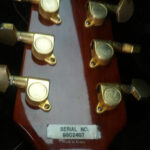Visualizing the guitar fretboard is a fundamental step for any aspiring guitarist. Understanding where each note lies across the fretboard opens up a world of possibilities for learning scales, chords, and improvising. A Guitar Fretboard Map is your essential tool for this journey, providing a clear and intuitive representation of the notes on your instrument.
Understanding the Guitar Fretboard Map
Think of a guitar fretboard map as a visual guide that lays out all the notes available on your guitar neck. It displays the strings horizontally and the frets vertically, creating a grid that pinpoints the exact location of each note. Typically, a fretboard map starts from the open strings and extends up to the higher frets, offering a comprehensive overview of the guitar’s sonic landscape.
This visual tool is invaluable because it allows you to:
- Identify Notes Quickly: Instead of memorizing each note individually, the map helps you see the patterns and relationships between notes across the fretboard.
- Learn Scales and Chords Visually: By seeing scales and chord shapes on the map, you can understand their construction and easily transpose them to different keys.
- Master Different Tunings: A good guitar fretboard map isn’t limited to standard tuning. It should adapt to popular alternative tunings like DADGAD, Drop D, Open G, Drop C, Double Drop D, and Open C, showing you how these tunings alter the note layout.
- Practice Effectively: With a clear map, your practice sessions become more focused and efficient as you can navigate the fretboard with confidence.
A guitar fretboard map illustrating notes in standard E A D G B E tuning, showing open strings and fret positions.
Key Features of an Interactive Guitar Fretboard Map
Modern guitar fretboard map tools often go beyond static diagrams. Interactive maps offer dynamic features that enhance your learning experience:
- Tuning Flexibility: Switch between various popular guitar tunings instantly and see how the note positions change in real-time. This is crucial for exploring different musical styles and sounds.
- Note Highlighting: Isolate specific notes on the fretboard to focus on particular intervals, scales, or chord tones. This visual emphasis aids in memorization and understanding.
- Scale Highlighting: Select a scale, and the map will highlight all the notes within that scale across the fretboard. This is an excellent way to learn scale patterns and visualize their application.
- Audio Playback: Hear the sound of individual notes directly from the map. This auditory feedback reinforces your visual learning and helps you connect note positions with their sounds. Options to choose between electric, acoustic, or nylon guitar samples can further enhance this experience.
- Left-Handed Mode: Cater to left-handed players by offering a mirrored fretboard view, ensuring inclusivity and ease of use for everyone.
Fretboard visualization adapted to Drop D tuning, highlighting the altered note positions on the low E string.
Why Use a Guitar Fretboard Map in Your Guitar Journey?
Whether you are a complete beginner or an experienced player, a guitar fretboard map is an invaluable asset.
- For Beginners: It provides a foundational understanding of note placement, making the initial stages of learning guitar less daunting and more intuitive.
- For Intermediate Players: It helps solidify your knowledge, explore new tunings, and delve deeper into music theory concepts like scales and modes.
- For Advanced Players: It serves as a quick reference and a tool for exploring unconventional tunings and complex musical ideas.
By utilizing a guitar fretboard map, you empower yourself to navigate the guitar neck with greater ease and unlock your full musical potential. Explore interactive fretboard map tools and start visualizing your musical journey today!

